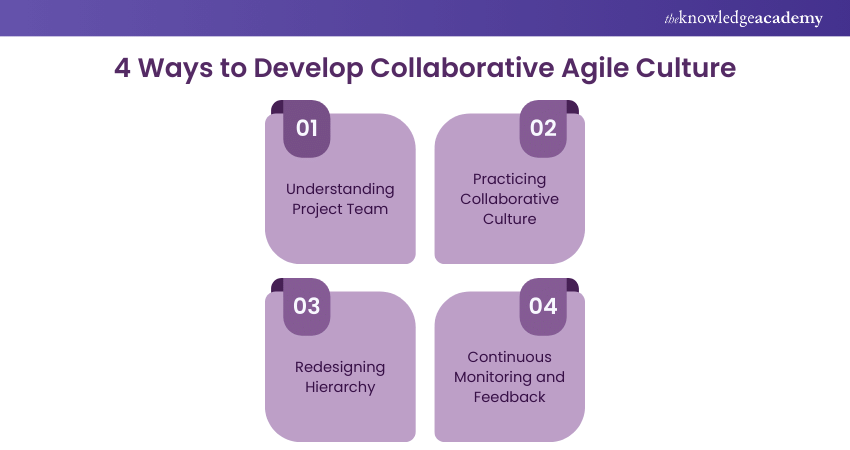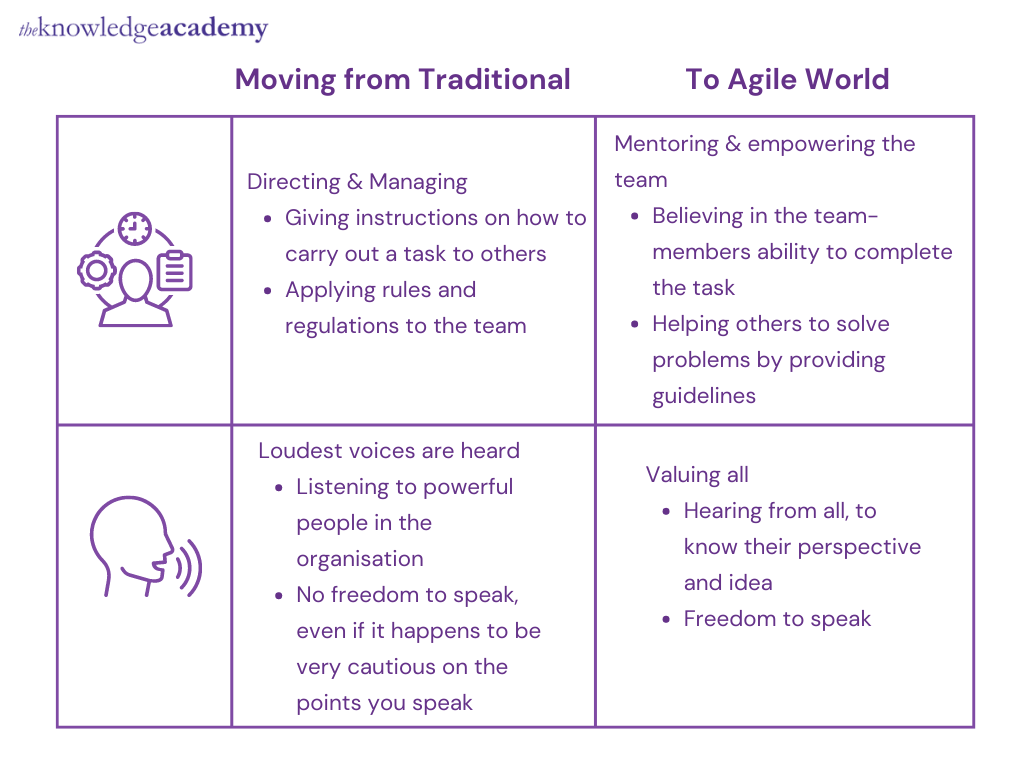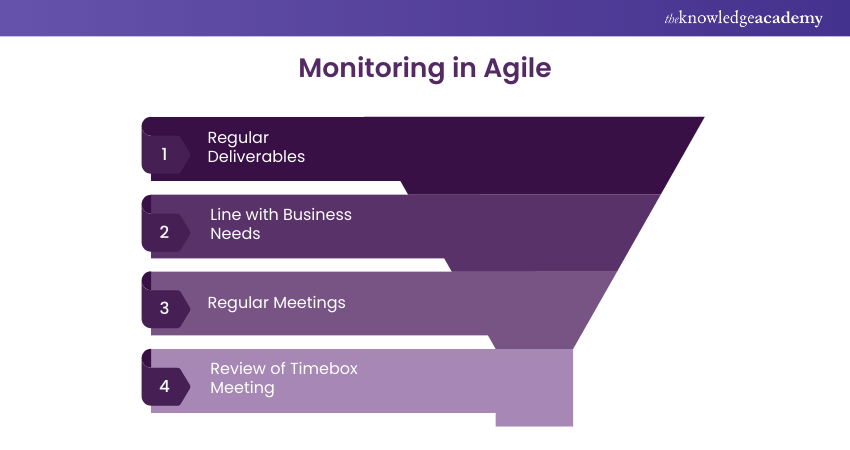We may not have the course you’re looking for. If you enquire or give us a call on +44 1344 203 999 and speak to our training experts, we may still be able to help with your training requirements.
Training Outcomes Within Your Budget!
We ensure quality, budget-alignment, and timely delivery by our expert instructors.

Agile culture has emerged as an effective method for product development with increasing software development across industries. Agile culture gives the organisation a strategic framework to deliver a high-quality software product. Agile facilitates transparency, a collaborative approach, better communication, self-organisation and exploration. For managing a project, learning agile would help you to boost productivity and collaboration. Projects that adopted Agile culture have 64% success rate and 60% spike in revenue and profit.
Table of Contents
1) Understanding Collaboration in Agile Culture
2) 4 Ways to Develop Collaborative Agile Culture
a) Understanding Project Team
b) Redesigning Hierarchy
c) Practicing Collaborative Culture
d) Continuous Monitoring and Feedback
3) Conclusion
Understanding Collaboration in Agile Culture
Agile thinking is a modern way of working with a collaborative approach. It’s more like people working together and talking at the same time. Are you still in a buzz? Wait we’ll explain. Agile technology is speed, efficient and highly responsive cross-platform for Project Management. The success strategy of the Agile framework lies in building a collaborative team and enhancing performance and outcomes. Although organisations promote collaboration and teamwork, it's not easy to implement. It requires more transparency in communication, trust, bond and teamwork to practice a modern product approach. A team/team member coming from traditional grounds may face technical bias in iteration, development model, test planning, estimation, etc., and other such as communication and hierarchy bias.
While adopting Agile culture, we need to make sure that the team is aware of technology, tools and processes. As this could sound sufficient because more technically driven people could prefer e-mail rather than going to meet to discuss the thought. In such cases, soft skills play a major role to bring them a team to accommodate without affecting the final product. Agile practitioners focus on the end product than on a rigid model. Thus, the teams are expected to be more flexible, transparent and accountable from their end, work on feedback and finally, the completion of the project. Therefore, cultivating Agile into the practitioners of traditional project style needs more interpersonal interactions, calls and pick-up chats.
4 Ways to Develop Collaborative Agile Culture
Currently, we all know that the software industry is marching towards agility and collaboration. So, let’s know how exactly we can work to develop collaborative Agile culture. Here are four ways.

Understanding Project Team
The essential factor you should remember while working in teams is to note that not all people are the same. All have varied educational backgrounds, project exposures and product managing experiences. As an individual, you may know your strength and weakness. Same way as a project manager try to understand the strength and weaknesses of everyone on the team and brainstorm challenges while implementing agile methodologies. This may help in building a good rapport and will provide a comfort zone among the team members. People are important, at the end of the day. The way your team works and brings productivity matters to the company. So, working on this would help you to practice the Agile methodology more effectively.
Redesigning Hierarchy
Being the CEO or manager is valued more by many people than doing tasks effectively and successfully. To overcome this, establish an environment where employees are valued for their results and the work they put in within the organisation. Agile focuses on one such way of transforming the hierarchy to lean leadership management. The traditional managing way is like micromanagement, where the manager would assign you tasks, observes and controls all employees. It has a more negative opinion and such a managing style would hinder growth. The drawbacks of the hierarchical way are listed below. They are
1) Everything is Based on Power
2) Even the boss seems to be like customer rather than one from your team
3) Totalitarian Leadership
4) Blunt Competitiveness
5) Financial Constraints
6) Highly Opaque
7) Often Scrutinising your Actions, Lack of Freedom
8) At Times it can Result in Destructive Personalities.
The Agile framework doesn’t have any hierarchical system. The Product Manager in Agile takes a back seat and facilitates
1) Common grounds for all
2) Self organised
3) Endless learning
4) Developing team members
5) Minimal constraints
6) Collaboration is vital
7) Openness
8) Distributed decision-making
The shift from traditional to Agile is like,
Learn Agile Project Management with our Agile Project Management Practitioner Course. Register now!

Hence, by the above-mentioned points, you could notice that Agile tech would benefit the organisation from a traditional to modern project approach with the intended culture shift.
Practicing Collaborative Culture
Companies know that team collaboration facilitates innovation. Team Collaboration is the process, where colleagues come together in a group to fix a problem or finish a project. Brainstorming is a good example of collaboration. Whereas, a group of people is said to be working as a team to fulfill their duties to accomplish a group objective. is called teamwork. For e.g.: The England team won the World Cup 2022.
In Agile, we need both teamwork and collaboration to happen. In order to practice this, we need to change the working pattern.
1) Modify workplace: Provide space for workshops, and think about "break-out" rooms for more relaxed talks to strengthen the working environment
2) Increased exposure to end users: Encouraging direct communication between the team and the user through face-to-face interaction, meetings, phone calls, or emails. By conducting cross-functional and end-user walkthroughs to provide the team with a fresh perspective and offer training
3) Allow knowledge transfer and pair programming
4) Company and customer goals are aligned with the goals of each team.
5) In order to find the best fit, team divisions and structures can be temporarily reorganized based on project needs
6) Encourage continual progress
7) Define exactly your expectations
8) Promote Agile behavior
9) Organising workshops, visual thinking, whiteboards, and teamwork are all effective ways to teach and reinforce soft skills
Cultivating these practices for a collaborative Agile culture would result in an effective model for developing practical solutions to uncertain situations.
Looking to impress in your Agile interview? Sharpen your knowledge with our handpicked selection of Agile Interview Questions and stand out from the crowd.
Continuous Monitoring and Feedback
Continuous monitoring and feedback are the incremental procedure to understand the functioning and final output of the product. Agile practitioners need to ensure all ongoing projects and retrospectives are reviewed. This is done to emphasis teamwork and interaction with the Agile culture that is integrated into the plan. Continuous monitoring and feedback in Agile will help you in tracking the current status of the project. The monitoring in Agile is of various forms, such as:

1) Regular deliverables
2) Line with business needs
3) Regular Meetings
4) Review of Timebox Meeting
The product increment is showcased during the Timebox Review Meetings at the stage of Product Demonstration. Maintaining an Agile culture is not only about collaboration you need to focus on projects monitor them regularly, refine their strategy and suggest feedback when needed, and repeat the process when needed. Agile culture would increase performance conversations among the employees to share the purpose and be engaged with both the project and team members.
Conclusion
In this blog, we have discussed the four best ways to develop Agile culture at your workplace. If you are considering a career as an Agile practitioner, visit the courses offered by The Knowledge Academy's Agile training courses. Register today!
Join our Agile Project Management Foundation and Practitioner Course to learn more about Agile Methodology!
Frequently Asked Questions
Upcoming Project Management Resources Batches & Dates
Date
 Agile Project Management Foundation & Practitioner (AgilePM®)
Agile Project Management Foundation & Practitioner (AgilePM®)
Mon 2nd Dec 2024
Mon 9th Dec 2024
Sat 14th Dec 2024, Sun 15th Dec 2024
Mon 16th Dec 2024
Mon 6th Jan 2025
Mon 13th Jan 2025
Mon 20th Jan 2025
Mon 27th Jan 2025
Mon 3rd Feb 2025
Mon 10th Feb 2025
Mon 17th Feb 2025
Mon 24th Feb 2025
Mon 3rd Mar 2025
Mon 10th Mar 2025
Mon 17th Mar 2025
Mon 24th Mar 2025
Mon 31st Mar 2025
Mon 7th Apr 2025
Mon 14th Apr 2025
Tue 22nd Apr 2025
Mon 28th Apr 2025
Tue 6th May 2025
Mon 12th May 2025
Mon 19th May 2025
Tue 27th May 2025
Mon 2nd Jun 2025
Mon 9th Jun 2025
Mon 16th Jun 2025
Mon 23rd Jun 2025
Mon 30th Jun 2025
Mon 7th Jul 2025
Mon 14th Jul 2025
Mon 21st Jul 2025
Mon 28th Jul 2025
Mon 4th Aug 2025
Mon 11th Aug 2025
Mon 18th Aug 2025
Mon 25th Aug 2025
Mon 1st Sep 2025
Mon 8th Sep 2025
Mon 15th Sep 2025
Mon 22nd Sep 2025
Mon 29th Sep 2025
Mon 6th Oct 2025
Mon 13th Oct 2025
Mon 20th Oct 2025
Mon 27th Oct 2025
Mon 3rd Nov 2025
Mon 10th Nov 2025
Mon 17th Nov 2025
Mon 24th Nov 2025
Mon 1st Dec 2025
Mon 8th Dec 2025
Mon 15th Dec 2025







 Top Rated Course
Top Rated Course



 If you wish to make any changes to your course, please
If you wish to make any changes to your course, please


